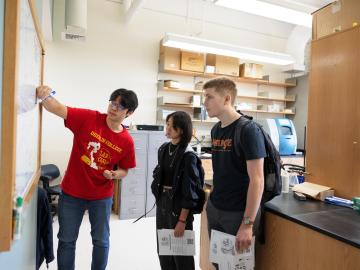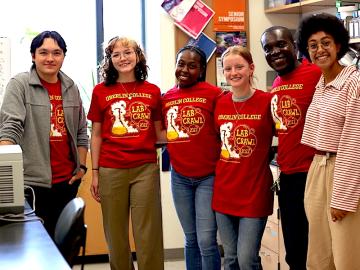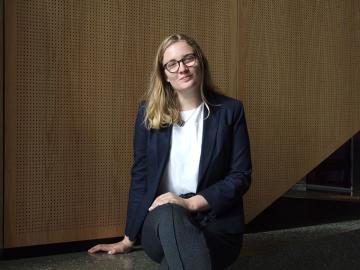A Summer Spent with Oberlin's Earliest Feminists
July 30, 2015
Kasey Cheydleur

In the Oberlin College Archives, reading through someone else’s diary is not frowned upon, it is encouraged. This summer, Professor of History Carol Lasser’s students are studying the diaries and personal papers of 19th- and early-20th-century Oberlin students as part of their historical research into first-wave feminism. Rising third-year students Natalia Shevin, Rebecca Debus, and Joanna Wiley are continuing and extending projects that began last spring in Lasser’s course on first-wave American feminism. In partnership with Oberlin College Archivist Ken Grossi, the class focused on working with primary documents in order to experience first-hand how historians make sense of evidence and better understand how race, class, sexuality, and other factors shape notions of gender justice.
The Oberlin College Archives is a particularly rich place to study first-wave American feminism because Oberlin was the first institution to grant bachelor’s degrees to women in a coeducational program. The papers contained in the archives give personal accounts of women’s lives in this transformative time in Oberlin and American history.
“I always forget that you have to explain to other people that Oberlin was a pioneer in the education of women, and as such Oberlin plays an important part in shaping strong women who may or may not be traditional feminists,” says Lasser, who was recently named president-elect of the Society for Historians of the Early American Republic—a professional organization of about 1,000 people dedicated to exploring the events and meaning of United States history between 1776 and 1861. With funding from a Mellon Grant for Digital Humanities given to the Ohio 5 Colleges, Lasser’s students are digging deep into the archives to discover the stories of these pioneering women, and they plan to publish their research on the Digitizing American Feminisms website.
Lasser and Grossi began the project in 2013 to allow students to experience the rewards of hands-on historical research grounded in the real world. For the first experience they gathered little-researched material from collections—including letters, photos, and personal papers— and let the students conduct their own research. Lasser says Grossi is “a fabulous archivist, and without his vision and enthusiasm this research would not be possible.” At the end of the semester, they were so impressed by the quality of the materials the students produced, they decided that the work needed a wider audience. Together they developed the Digitizing American Feminisms website, which will soon house the results of the hard work put into their projects by Lasser’s 2013 and 2015 classes.
One of the projects under way this summer is a deep look into the life of Mary Church Terrell, a civil rights leader and a founding member of the National Association for the Advancement of Colored People (NAACP), who earned a bachelor’s degree at Oberlin in 1884—making her one of the first African American women to do so. Shevin says that she elected to continue researching Terrell this summer because “I really never felt prouder about something that I worked on in college before. I was curious to do more research about her, as well as continuing to look at other collections and different aspects of first-wave feminisms.”
Working in the archives and looking this extensively into a single subject has given Shevin a new perspective on historical research. “I’ve learned that it’s slow! Just today I started reading a whole book on Mary Church Terrell’s father just to add one discursive footnote about him,” she says. “Without this backstory, the documents would be flatter. Having all of the context really makes history 3D in a way I haven’t experienced before.”
Wiley’s project focuses on Luella Miner, a missionary who founded the first women’s college in China, the North China Union College for Women. “She had to have this great vision of what women’s education is supposed to be,” says Lasser, “and that is in part derived right from her own Oberlin experience.” Wiley says that she enjoys transcribing handwritten letters and the satisfaction gained from tracking down leads to find more information. She has also been surprised by “how much I have come to care about documenting my subjects.”
Debus is looking into the letters of Henry and Lucy Woodcock, siblings who attended Oberlin in the 19th century. The letters reveal the changing attitudes toward gender during the period. Debus says her favorite part of the research is “finding out the small details about the lives of individual people, their dreams and ambitions, as well as their sorrows and their everyday lives. It makes the past seem so real and present.”
Developing this sense of history being complicated and alive is one of Lasser’s main goals for her students. “I want them to get a sense of the ‘pastness of the past’ and the ‘presentness of the past.’ History sometimes connects us with people who lived before us, but it also challenges us to understand that they lived their lives within constraints that are not always ‘relatable.’ This distance is important in appreciating human difference.” She wants her students to learn that “people in the past changed the world, and they can too.”
Debus says Lasser’s ability to raise the big questions is one of her best qualities as a mentor. “She’s really good at helping us focus our projects. It’s easy to get mired in the details of a project and start to lose the big picture. She really helps us pull back and visualize the project as a whole.”
In August, the students will attend the annual meeting of the Society of American Archivists in Cleveland, where they will be the only undergraduate student presenters. The Society of American Archivists was founded in 1936 and is the largest archivist professional association in the United States.
Tags:
You may also like…
Friday Afternoon with Lab Crawl
October 30, 2023
This year’s Lab Crawl drew what may be the largest crowd in the event’s illustrious history, with some 500 students and dozens of faculty taking part. Missed out on the excitement? It looked something like this.
Lab Crawl: It’s Not Just for Scientists
October 24, 2023
Oct. 27 open house highlights research across the sciences—and just about everywhere else.
In the Path of Disaster
August 28, 2023
Monica Dix travels to a hub of natural calamity to probe its risks and resilience.


